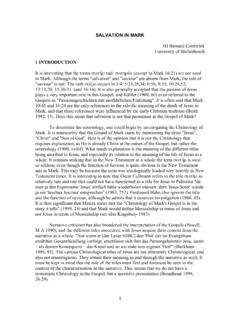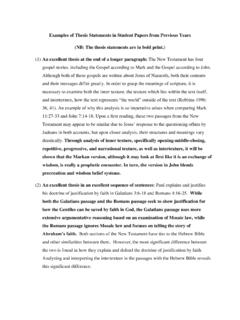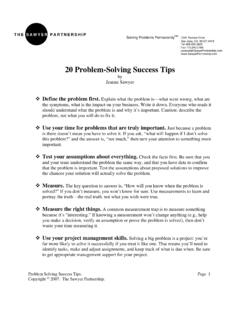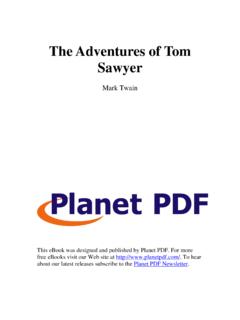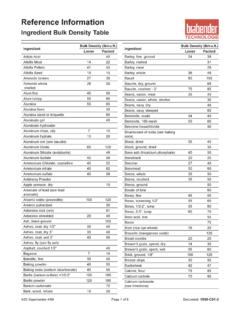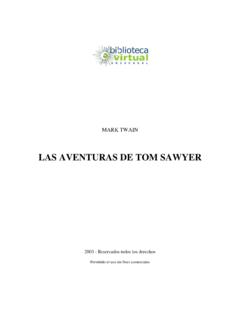Transcription of Nota Bene-- C: bwinDOCUMENTJohn GospelSawyer …
1 Eyes wide open, seeing nothingThe challenge of the Gospel of John s non-vizualizable texture for readings using visual textureL. Gregory BloomquistSaint Paul UniversityFaculty of TheologyIntroductionI d like you to visualize God. If you are able to do so, your visualization of God is probably drawn from images that you have seen of God. These images themselves are drawn from various sources: stained glass windows, statuary, children s Bibles, shrines, stories that you have heard. You may imagine a patriarchal style God with long beard, a multi-armed God fighting with a sword in each of many hands, a triangle with an eye, etc. The task I assigned you is probably much harder if you are Jewish or Muslim, but it is not impossible. You might envision a fire, or an opening in the clouds. Or, you might be able to visualize the name of God written in calligraphic letters. But the aniconism of both religions probably leaves you unable to undertake the task.
2 Next I d like you to visualize life. Not a particular form of life, like a lily, or a monkey, or your friend sitting next to you. I want you to envision life itself. Can you do it? If you can, it is probably a rushed mixture of all sorts of specific and generic images all blended , I d like you to visualize light. Again, not a particular form of light, like a light bulb, or the sun streaming through the window, nor even the source of light, like a campfire at night or the sun by day. I want you to envision light itself. Can you do it? If you can, it is probably a blinding whiteness, which we know is what we see when our eye sees all of the wavelengths of the visible spectrum in a rushed mixture of them all together, at full brightness and without absorption .1 Finally, and most difficult of all, I want you to visualize reason. What do you see? You might see a woman frowning, deep in thought. You might see in your mind what you imagine to be an fMRI scan, with the computerized depiction of increased oxygen flow in the prefrontal lobe.
3 But, these are all reflections in your mind of visualizations of humans engaged in a process that involves reason and much else. But, can you visualize reason itself?Or, if instead of trying to visualize reason, I asked you to visualize speech? Not speaking. That would be relatively straightforward: you would picture a man or woman s mouth in the process of uttering something, be it intelligible to you or not. Can you visualize speech itself? Unless you have the unusual ability that some people may have to see sound-waves, my guess is that you find this challenge as difficult as trying to visualize opening verses of John s Gospel, verses that many of us consider to be of such lofty poetic expression that they rank among the few passages in the New Testament that we consider worthy of great literature, verses that many Christians associate with the second greatest feast of the Christian year, Christmas, when these verses are annually read aloud around the world, set before the hearer these very same the beginning was the Word, and the Word was with God, and the Word was God.
4 2 He was in the beginning with God. 3 All things came into being through him, and without him not one thing came into being. What has come into being 4 in him was life, and the life was the light of all people. 5 The light shines in the darkness, and the darkness did not overcome it. (John 1:1-5 NRS)God, life, light. Word , which in Greek, means reason or speech . And note, one could have pushed this even further. Can you visualize the beginning? That time before which something existed? How about all things , or being , or even darkness . 2 1. , perhaps darkness is the one thing that you can visualize because when you close your eyes, you see nothing, not even light . It is the absence of everything that can be visualized and strikingly, that, we can kind of visualize.
5 With that one exception, to which I will return, can anything of these opening few verses of John s Gospel be visualized? What is the purpose of setting before you tasks that seem destined to fail? Surely, this is poor reason is a very simple even if you cannot immediately visualize it. It is this. If Vernon Robbins is correct in his assertion that rhetorical address relies primarily though not exclusively on the use of images that are set before hearers,2 and that where one is set up for the scenario that these images displays is at the start of a text, then the Gospel of John in its opening words presents its hearers with an impossible task and may be off to a failed start. An alternative is that Robbins s assertion is , we are talking about a Gospel in which seeing or sight is considered to be one of the main actions or themes of the entire Gospel. There is no other New Testament text in which the theme of seeing and vision , or ironic inversions of the notion of vision , are as central.
6 It is a Gospel that hinges as no other canonical Gospel does on what the reader sees, and this according to the Gospel , John s Gospel stands as an important test case for Robbins s assertion. It is a text that requires that we probe Robbins s assertion more fully and gives us an excellent, though in the end paradoxically satisfying, opportunity to do so. Sociorhetorical interpretation and rhetographySociorhetorical analysis or interpretation (henceforth SRI), as developed by Vernon Robbins, is itself a development of classical and modern rhetoric. Drawing on both, as well as the tools made available to us in social and cultural studies, SRI is an attempt to get at the strategies by which humans communicate in full-bodied ways, , in the context of lived experience. It is a form of rhetorical analysis 3 2.
7 An assertion that is at odds with the assertions of many specialists in textual materials for whom arguments and concepts are what really sustain rhetorical seeks to understand the rhetorical discourse found in written texts as the by-product of the communication by actual people with bodies and minds living out their existence with others within their social, cultural, and ideological geography. This is why for years I have termed it, in contrast to several other forms of biblical exegesis, full-bodied .3 According to Robbins, we get at this full-bodied experience of human communication through an analysis of the varieties of strategies used in human communication. Such strategies include probes into three primary arenas of human communication. First, there is the material that is internal to the speech or text and which can function perfectly well within the speech or text itself without drawing on any considerable understanding of the world around the text.
8 For example, to understand and enjoy Shakespeare s Macbeth, one does not need a full course in Shakespeare, Shakespeare s England, or medieval Scottish history. In the case of the first arena, for which I use Robbins s term innertexture, there are several strategies that Robbins s has identified: analysis of repetitive and progressive texture, which reveals the ways in which words, phrases, and topics form patterns throughout a text,4 analysis of its opening-middle-closing texture, which provides the limits of a rhetorical unit, as well as the boundaries of the flow of that unit,5 analysis of the narrational texture, which deals with the patterns formed by the voices, actions, relationships, etc. of those in the text, , narrator and actors,6 analysis of the sensory-aesthetic texture and pattern, which presents the way that bodies, body zones, and motions, including both those external bodily actions -- purposeful action -- as well as the self-expressive and internal or emotion-fused 4 3.
9 I used the expression in a presentation on SRI and Wittgenstein, a philosopher known for trying to get at the meaning of people s real speech. See L. Gregory Bloomquist, The Possibility of Biblical Studies in a Post-Wittgensteinian World, Paper presented at the round-table discussion Theology after Wittgenstein in honour of Prof. Fergus Kerr s presence at Saint Paul University (2005).4. Vernon K. Robbins, Exploring the Texture of Texts: A Guide to Socio-Rhetorical Interpretation (Valley Forge: Trinity Press International, 1996), 8 Ibid., 19 Ibid., 15 of the mind, heart, bowels, etc. are presented in the text,7 and analysis of the argumentative texture, to which I will , were one to have the background material regarding Shakespeare s world, or that of Macbeth, one could probably understand and enjoy other aspects of the text that would not otherwise yield themselves to a hearer or reader. This material, which is external to the text but that intersects the text in some way and allows it to make fuller sense to a reader is the second arena probed by SRI.
10 Analysis of this material, for which I also use the term that Robbins uses, intertexture, though in a slightly different way, relies on analysis of the way in which elements outside the text intersect the text. For example, the social world of human phenomena and action are present in some measure in all texts. How? Possibly in the form of eating, or dwelling, or transportation, or governance, etc. But, these actions are also couched in local form, in which one culture engages human action in ways that are similar to or different from another culture. In this category of local action, I include all the materials and interpretations of legends and texts found in one culture or another. But, finally, with Macbeth as with all texts, one eventually asks: so what? What makes Macbeth interesting, or work, or be compelling, This so what? question can engage both the first and second arenas, or one or the other, but it also exists somewhat independently of both.


